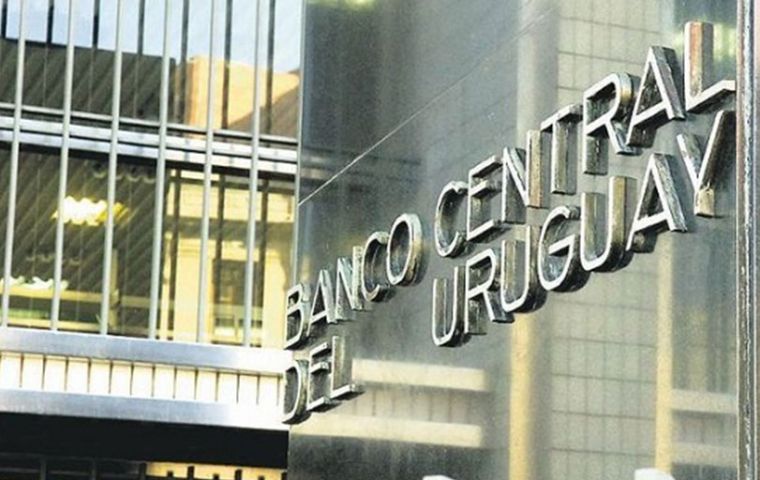MercoPress. South Atlantic News Agency
IMF: Uruguay advances important reforms amid the pandemic
 The Uruguay Central bank has announced the intention to lower the inflation target upper bound from 7 to 6 percent by September 2022.
The Uruguay Central bank has announced the intention to lower the inflation target upper bound from 7 to 6 percent by September 2022.  As one of the most dollarized countries in the world, Uruguay also renewed the emphasis on reducing dollarization and promoting local peso currency markets.
As one of the most dollarized countries in the world, Uruguay also renewed the emphasis on reducing dollarization and promoting local peso currency markets. By S. Pelin Berkmen, Dmitry Gershenson, Luis Herrera Prada, and Jose Torres - Despite the ongoing crisis, Uruguay is taking important steps to address preexisting macroeconomic conditions and lay the foundation for a more resilient, competitive, and stable economy.
Deft crisis management and long-standing institutional strengths (such as its public health system) allowed Uruguay to keep the number of infections and deaths relatively low until late 2020, thereby mitigating the social and economic costs.
These circumstances allowed the newly-elected government the opportunity to introduce a series of reforms aimed at raising growth and employment: upgrading the fiscal policy framework; modernizing the inflation targeting regime; and boosting competitiveness and private investment, while increasing the efficiency of state-owned enterprises, a significant part of the Uruguayan economy.
Better fiscal policy to stabilize debt and save during good times
Aiming to avoid excessive spending in boom times—a perennial problem in Uruguay and many emerging countries—and ensure debt sustainability, the country is proposing new medium-term budget guidelines. The new fiscal framework will feature a rolling five-year forecast horizon with more frequent updates (useful in the current high uncertainty environment); a rainy-day fund to accumulate savings; a fiscal council (to provide independent assessment and enhance accountability); a commission to advance pension reform (a key reform to ensure medium-term fiscal sustainability); and, last but not least, a new fiscal rule to stabilize debt and encourage savings during good times.
A new monetary framework
Following long periods of above-target inflation, the central bank is enhancing its monetary policy framework. By reaffirming the primacy of low inflation as its medium-term objective, it has elevated it above other objectives also pursued before. To support that, it announced the intention to lower the inflation target upper bound from 7 to 6 percent by September 2022.
The central bank doubled the frequency of its monetary policy meetings to better react to rapidly changing conditions (especially important at a pandemic time) and started publishing the minutes of those meetings to improve transparency and communication. Finally, it will focus on the basic interest rate as main policy instrument, as opposed to the money supply growth rate. Being one of the most dollarized countries in the world, Uruguay also renewed the emphasis on reducing dollarization and promoting local peso currency markets.
A more efficient economy for higher private investment
With fuel, water, and electricity produced and distributed by public companies, which charge relatively high prices by regional standards, Uruguay is an expensive place to do business. As part of a strategy to improve the environment for private investment and eliminate excessive costs, the government has proposed a set of measures to better regulate state-owned enterprises, introduce stronger and more independent regulatory agencies, and gradually reduce utility prices. In addition, the authorities envisage a reform of the education system in order to alleviate the existing problems of high dropout rates and high youth unemployment, and to facilitate a transition toward new—less contact-intensive—sectors that are expected to become more prominent in the wake of the pandemic.
Challenging road ahead
The challenges facing Uruguay are not trivial. The near-term outlook is subject to large risks, stemming from the rapidly rising number of COVID-19 cases and the likelihood that widespread vaccination will take time, the unfavorable regional and global environment, and ongoing structural shifts, such as falling labor participation and a shrinking manufacturing sector. The success of these reforms in generating growth and reducing macroeconomic imbalances will depend on the exact nature of the measures adopted, and these details are still being discussed in Parliament and among other stakeholders.
Nevertheless, the reforms already enacted or announced—broadly in line with earlier Fund recommendations—are the building blocks for a stronger, more resilient, and equitable economy. They improve the responsiveness of fiscal and monetary policies to the changing circumstances, increase accountability of the policy makers, and establish medium-term anchors and credibility necessary during these uncertain times. Complementing long-standing institutional strengths, these reforms will help align Uruguay’s macro policies with international best practices.




Top Comments
Disclaimer & comment rulesCommenting for this story is now closed.
If you have a Facebook account, become a fan and comment on our Facebook Page!